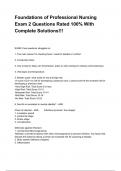Foundations of Professional Nursing
Exam 2 Questions Rated 100% With
Complete Solutions!!!
EXAM 2 test questions struggled on:
1. The main reason for checking fever= need for blanket or comfort
2. Conduction=bear
3. how to test for deep vein thrombosis= press on skin looking for redness and tenderness
4. Vital signs and temperature
5. Braden scale- what scale for low and high risk
-A score of 23= no risk for developing a pressure ulcer. Lowest score=6 the severest risk for
developing a pressure ulcer.
-Very High Risk: Total Score 9 or less
-High Risk: Total Score 10-12
-Moderate Risk: Total Score 13-14
-Mild Risk: Total Score 15-18
-No Risk: Total Score 19-23
6. Sex life is correlated to mental stability? - ANS
Chain of infection - ANS Infectious process= four stages:
1. incubation period
2. prodromal stage
3. illness stage
4. convalescece
Defenses against infection=
1. normal flora (Microorganisms)
-Maintain a sensitive balance with other microorganisms to prevent infection. Any factor that
disrupts this balance places a person at increased risk for acquiring a disease.
2. Body system defenses (Organs)
3. Inflammation
,-Signs of local inflammation and infection are identical.
-Vascular and cellular responses
-Exudates (serous, sanguineous, or purulent)
-Tissue repair
Types of HAI (Health Care-Associated) infection:
1. Iatrogenic—from a procedure
2. Exogenous—from microorganisms outside the individual
3. Endogenous—when the patient's flora becomes altered and an overgrowth results
Chain of infection QUIZ!!!!
1. what Is a portal of exit
2. is touching your face after washing your hands, a break of asepsis
3. why is the host susceptible
4. what are the modes of transmission from the scenario?
5. what is the best intervention to prevent spreading an infectious agent
6.
sneezing=
incison=
chemotherapy=
alien marcrobes=
wife=
vectors=
8. which of the following are vectors?
9. what are the portals of entry? - ANS 1. sneezing
2. true
3. right arm incision, poor nutritional status, and chemotherapy
4. vectors-insects, dropped used tissues, a spray of mucus
5. hand washing
6. portal of exit
portal of entry/susceptible host
susceptible host
infectious agent
reservoir
transmission
7. portal of exit, portal of entry, susceptible host, infectious agent, reservoir, transmission
8. dust particles, trash, insects
9. mouth, nose, right arm incision
Documentation Powerpoint!!! - ANS
5 characteristics of quality documentation and reporting - ANS 1. Factual
avoid opinions, "appears" or "seems"
,use client's exact words in quotations.
2. Accurate
"adequate amount" vs. "360 ml"
correct spelling
no unapproved abbreviations
3. Complete
pertinent data but don't write a novel
4. Current
timely, chart as soon as intervention is complete
5. Organized
logical order, concise, clear, to the point
example - head-to-toe assessment
Subjective data - client's description of episode
Use quotes, if narrative charting
Information: onset, location, severity, duration, frequency, precipitating, aggravating, and
relieving factors—describe in their words
use client's own words
Client behavior - confusion, anxiety
Question to gain information on: onset, behaviors exhibited, precipitating factors, client's verbal
behavior
Objective data - what you find: rash, tenderness, breath sounds Onset, location, description
-Treatments - what you did (bath, enema, dressing change)
--Time completed, equipment used, client's response (can include both objective and subjective
data collection)
-Medication administration- concurrently with medication administration or immediately after
administration; also document: time medication given, preliminary assessment findings
-Client Teaching - information presented, method of instruction, client response
-Discharge Planning - measurable client goals or expected outcomes, progress towards goals,
need for referrals
-Contacts - contacts with other health care professionals for the benefit of the client
order requests, consults
Methods of documentation - ANS -Paper and electronic health records
-Narrative documentation
-Problem-Oriented medical record
-Source record
-Charting by exception - know what "normals" are
-Case management plan and critical pathways
Electronic health record electronic medical record:
, -Digital version of the client's medical record
-Longitudinal electronic record of client health information generated by one or more encounters
in any care delivery system
-Provides continuity of care from one episode of illness to another
-Mandated by federal regulation
-Facilitates institutional evaluation of nursing care services
Electronic Health Record Paper Medical Record:
-record of rapidly changing emergencies such as a code blue (resuscitation) or rapid response
-Backup record when the computer systems are down or under maintenance
-Paper forms are scanned into client's record after the fact
SOAP/SOAPIE Notes:
-SOAP
S=Subjective-client's verbalization
O=Objective-what is measured and observed
A=Assessment-diagnosis based on the data
P=Plan-what you are going to do
-SOAPIE
I=Intervention-how you are going to do it
E=Evaluation-did it work/modifications made
PIE notes:
-PIE notes are also problem oriented with a nursing origin
P=Problem
I=Intervention
E=Evaluation
-Labeled or numbered according to the client's problems
-Resolved problems are dropped
-Continued problems - addressed daily
Focus Charting:
-Narrative Form
-Use of DAR notes
D=data (both subjective and objective)
A=Action or nursing intervention
R=Response of client (successful or not?)
-A different approach not designed for just problems—includes client's concerns not just
problem areas, follows the nursing process
Common record keeping forms - ANS -Admission nursing history forms
-Flow Sheets/Graphic Records - VS, hygiene
-Client summary - updated frequently
--Provides current orders, treatment, diagnostics, activity, diet




